stop start VOLVO XC70 2003 Owners Manual
[x] Cancel search | Manufacturer: VOLVO, Model Year: 2003, Model line: XC70, Model: VOLVO XC70 2003Pages: 257, PDF Size: 5.33 MB
Page 32 of 257

2003 VOLVO XC70
Occupant safety
How safely you drive doesn't depend on how old you are but rather on:
l How well you see.
l Your ability to concentrate.
l How quickly you make decisions under stress to avoid an accident.
The tips listed below are suggestions to help you cope with the ever cha\
nging traffic environment.
l Never drink and drive.
l If you are taking any medication, consult your physician about its poten\
tial effects on your driving
abilities.
l Take a driver-retraining course
l Have your eyes checked regularly
l Keep your windshield and headlights clean.
l Replace wiper blades when they start to leave streaks.
l Take into account the traffic, road, and weather conditions, particularl\
y with regard to stopping
distance.
Reporting Safety Defects in the U.S.
If you believe that your vehicle has a defect which could cause a crash \
or could cause injury or death,
you should immediately inform the National Highway Traffic Safety Admini\
stration (NHTSA) in
addition to notifying Volvo Cars of North America. If NHTSA receives sim\
ilar complaints, it may open
an investigation, and if it finds that a safety defect exists in a group\
of vehicles, it may order a recall and
remedy campaign. However, NHTSA cannot become involved in individual pro\
blems between you,
your retailer, or Volvo Cars of North America. To contact NHTSA, you may\
either call the Auto Safety
Hotline toll-free at 1-800-424-9393 (or 202-366-0123 in Washington, D.C\
. area) or write to: NHTSA, U.
S. Department of Transportation, Washington D.C. 20590. You can also obt\
ain other information about
motor vehicle safety from the Hotline.
Volvo strongly recommends that if your vehicle is covered under a servic\
e campaign, safety or emission
recall or similar action, it should be completed as soon as possible. Pl\
ease check with your local retailer
or Volvo Cars of North America, LLC. if your vehicle is covered under th\
ese conditions.
NHTSA can be reached at:
Internet :
http://www.nhtsa.dot.gov
Telephone:
1-888-DASH-2-DOT (1-888-327-4236) (toll free)
1-800-424-9393 (toll free)
1-202-366-0123 (in Washington DC area)
file:///K|/ownersdocs/2003/2003_XC70/03xc70_01b.htm (9 of 14)12/30/200\
6 4:17:52 PM
Page 34 of 257
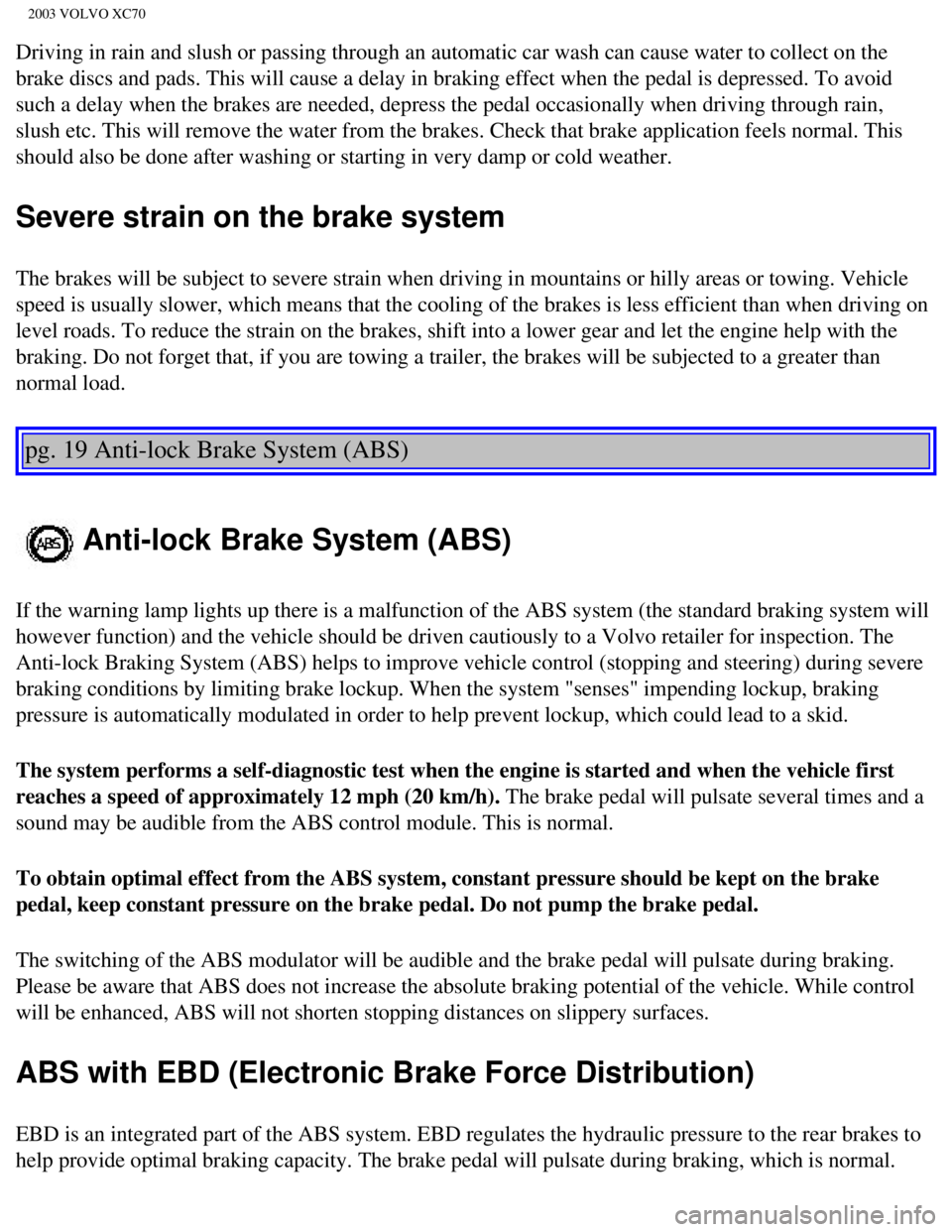
2003 VOLVO XC70
Driving in rain and slush or passing through an automatic car wash can c\
ause water to collect on the
brake discs and pads. This will cause a delay in braking effect when the\
pedal is depressed. To avoid
such a delay when the brakes are needed, depress the pedal occasionally \
when driving through rain,
slush etc. This will remove the water from the brakes. Check that brake \
application feels normal. This
should also be done after washing or starting in very damp or cold weath\
er.
Severe strain on the brake system
The brakes will be subject to severe strain when driving in mountains or\
hilly areas or towing. Vehicle
speed is usually slower, which means that the cooling of the brakes is l\
ess efficient than when driving on
level roads. To reduce the strain on the brakes, shift into a lower gear\
and let the engine help with the
braking. Do not forget that, if you are towing a trailer, the brakes wil\
l be subjected to a greater than
normal load.
pg. 19 Anti-lock Brake System (ABS)
Anti-lock Brake System (ABS)
If the warning lamp lights up there is a malfunction of the ABS system (\
the standard braking system will
however function) and the vehicle should be driven cautiously to a Volv\
o retailer for inspection. The
Anti-lock Braking System (ABS) helps to improve vehicle control (stop\
ping and steering) during severe
braking conditions by limiting brake lockup. When the system "senses" im\
pending lockup, braking
pressure is automatically modulated in order to help prevent lockup, whi\
ch could lead to a skid.
The system performs a self-diagnostic test when the engine is started an\
d when the vehicle first
reaches a speed of approximately 12 mph (20 km/h). The brake pedal will pulsate several times and a
sound may be audible from the ABS control module. This is normal.
To obtain optimal effect from the ABS system, constant pressure should b\
e kept on the brake
pedal, keep constant pressure on the brake pedal. Do not pump the brake \
pedal.
The switching of the ABS modulator will be audible and the brake pedal w\
ill pulsate during braking.
Please be aware that ABS does not increase the absolute braking potentia\
l of the vehicle. While control
will be enhanced, ABS will not shorten stopping distances on slippery su\
rfaces.
ABS with EBD (Electronic Brake Force Distribution)
EBD is an integrated part of the ABS system. EBD regulates the hydraulic\
pressure to the rear brakes to
help provide optimal braking capacity. The brake pedal will pulsate duri\
ng braking, which is normal.
file:///K|/ownersdocs/2003/2003_XC70/03xc70_01b.htm (11 of 14)12/30/20\
06 4:17:52 PM
Page 35 of 257
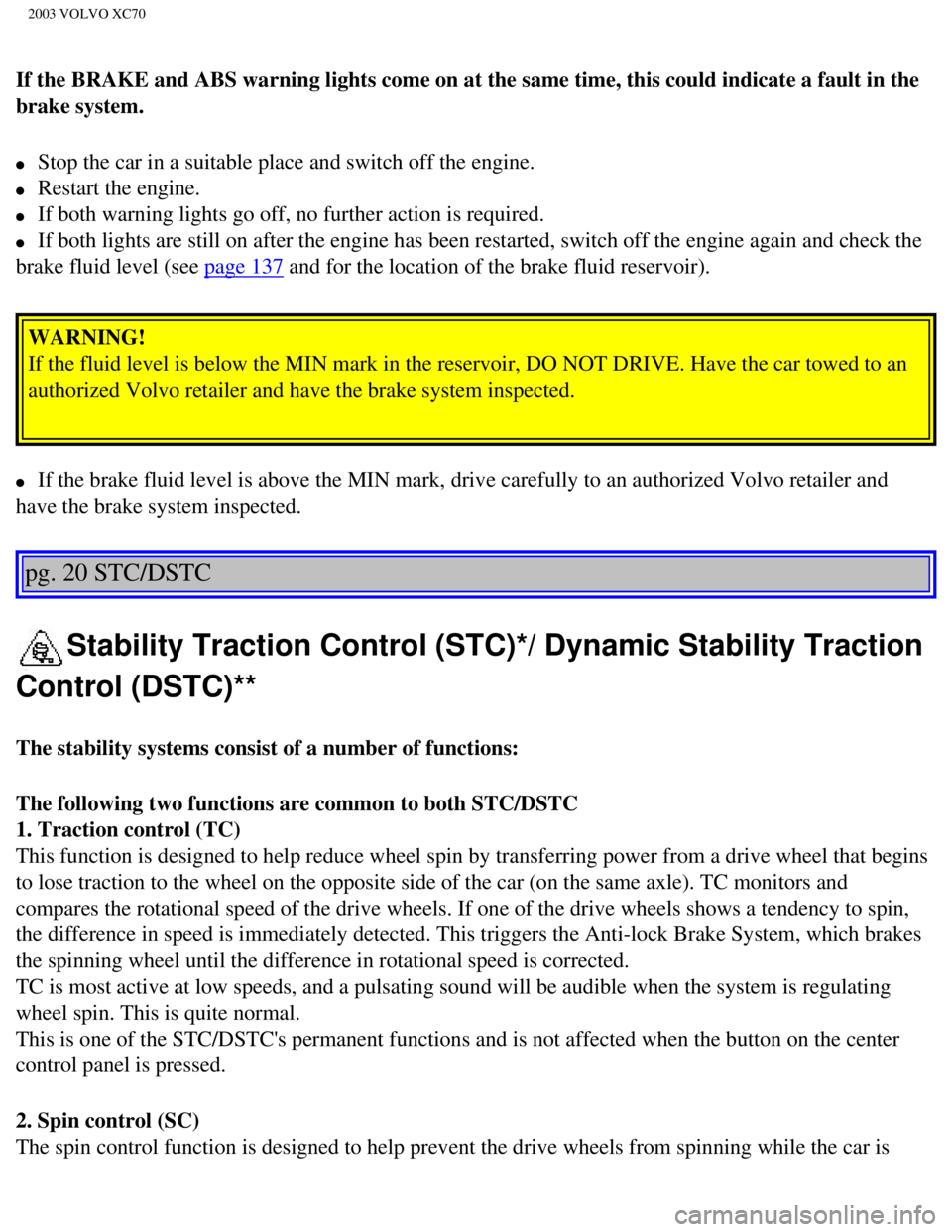
2003 VOLVO XC70
If the BRAKE and ABS warning lights come on at the same time, this could\
indicate a fault in the
brake system.
l Stop the car in a suitable place and switch off the engine.
l Restart the engine.
l If both warning lights go off, no further action is required.
l If both lights are still on after the engine has been restarted, switch \
off the engine again and check the
brake fluid level (see
page 137 and for the location of the brake fluid reservoir).
WARNING!
If the fluid level is below the MIN mark in the reservoir, DO NOT DRIVE.\
Have the car towed to an
authorized Volvo retailer and have the brake system inspected.
l If the brake fluid level is above the MIN mark, drive carefully to an au\
thorized Volvo retailer and
have the brake system inspected.
pg. 20 STC/DSTC
Stability Traction Control (STC)*/ Dynamic Stability Traction
Control (DSTC)**
The stability systems consist of a number of functions:
The following two functions are common to both STC/DSTC
1. Traction control (TC)
This function is designed to help reduce wheel spin by transferring powe\
r from a drive wheel that begins
to lose traction to the wheel on the opposite side of the car (on the s\
ame axle). TC monitors and
compares the rotational speed of the drive wheels. If one of the drive w\
heels shows a tendency to spin,
the difference in speed is immediately detected. This triggers the Anti-\
lock Brake System, which brakes
the spinning wheel until the difference in rotational speed is corrected\
.
TC is most active at low speeds, and a pulsating sound will be audible w\
hen the system is regulating
wheel spin. This is quite normal.
This is one of the STC/DSTC's permanent functions and is not affected wh\
en the button on the center
control panel is pressed.
2. Spin control (SC)
The spin control function is designed to help prevent the drive wheels f\
rom spinning while the car is
file:///K|/ownersdocs/2003/2003_XC70/03xc70_01b.htm (12 of 14)12/30/20\
06 4:17:52 PM
Page 43 of 257
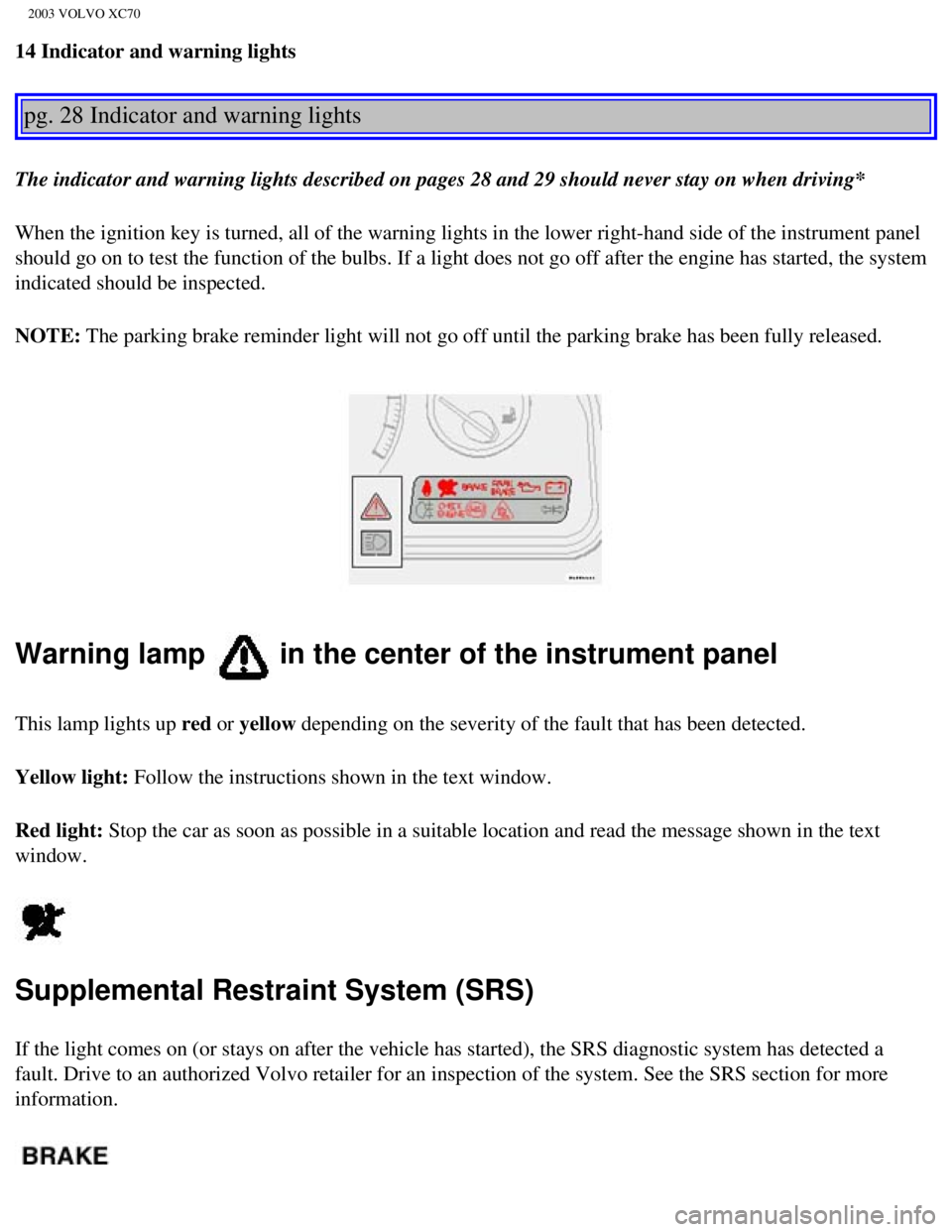
2003 VOLVO XC70
14 Indicator and warning lights
pg. 28 Indicator and warning lights
The indicator and warning lights described on pages 28 and 29 should nev\
er stay on when driving*
When the ignition key is turned, all of the warning lights in the lower \
right-hand side of the instrument panel
should go on to test the function of the bulbs. If a light does not go o\
ff after the engine has started, the system
indicated should be inspected.
NOTE: The parking brake reminder light will not go off until the parking brake\
has been fully released.
Warning lamp in the center of the instrument panel
This lamp lights up red or yellow depending on the severity of the fault that has been detected.
Yellow light: Follow the instructions shown in the text window.
Red light: Stop the car as soon as possible in a suitable location and read the me\
ssage shown in the text
window.
Supplemental Restraint System (SRS)
If the light comes on (or stays on after the vehicle has started), the\
SRS diagnostic system has detected a
fault. Drive to an authorized Volvo retailer for an inspection of the sy\
stem. See the SRS section for more
information.
file:///K|/ownersdocs/2003/2003_XC70/03xc70_02a.htm (6 of 13)12/30/200\
6 4:17:53 PM
Page 44 of 257

2003 VOLVO XC70
Brake failure warning light
If the light comes on while driving or braking, stop immediately, open t\
he hood and check the brake
fluid level in the reservoir. See
page 134 for reservoir position and page 137 for instructions.
Canadian models are equipped with this warning light:
Oil pressure warning light
If the light comes on while driving, stop the car and then stop the engi\
ne immediately and check the
engine oil level. See
page 135. If the light stays on after restart, have the car towed to the nearest\
authorized
Volvo retailer. After hard driving, the light may come on occasionally w\
hen the engine is idling. This is
normal, provided it goes off when the engine speed is increased.
Parking brake reminder light
This light will be on when the parking brake (hand brake) is applied. \
The parking brake lever is situated
between the front seats.
Canadian models are equipped with this warning light:
Generator warning light
If the light comes on while the engine is running, have the charging sys\
tem checked.
* Rear fog light, if used, and trailer turn signal, if towing a trailer,\
will go on while driving.
pg. 29 Indicator and warning lights
file:///K|/ownersdocs/2003/2003_XC70/03xc70_02a.htm (7 of 13)12/30/200\
6 4:17:53 PM
Page 47 of 257
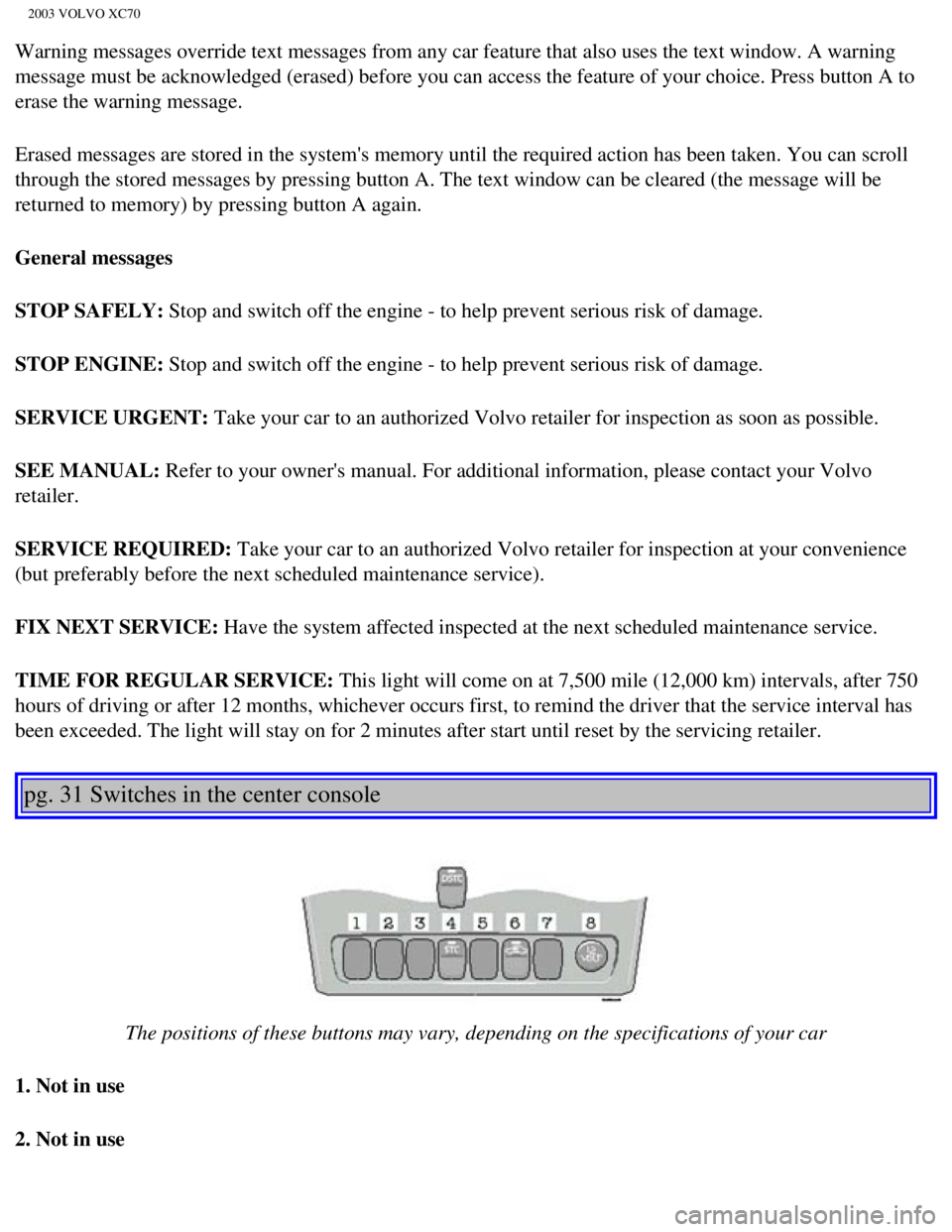
2003 VOLVO XC70
Warning messages override text messages from any car feature that also u\
ses the text window. A warning
message must be acknowledged (erased) before you can access the featur\
e of your choice. Press button A to
erase the warning message.
Erased messages are stored in the system's memory until the required act\
ion has been taken. You can scroll
through the stored messages by pressing button A. The text window can be\
cleared (the message will be
returned to memory) by pressing button A again.
General messages
STOP SAFELY: Stop and switch off the engine - to help prevent serious risk of damage\
.
STOP ENGINE: Stop and switch off the engine - to help prevent serious risk of damage\
.
SERVICE URGENT: Take your car to an authorized Volvo retailer for inspection as soon as \
possible.
SEE MANUAL: Refer to your owner's manual. For additional information, please contact\
your Volvo
retailer.
SERVICE REQUIRED: Take your car to an authorized Volvo retailer for inspection at your con\
venience
(but preferably before the next scheduled maintenance service).
FIX NEXT SERVICE: Have the system affected inspected at the next scheduled maintenance ser\
vice.
TIME FOR REGULAR SERVICE: This light will come on at 7,500 mile (12,000 km) intervals, after 750\
hours of driving or after 12 months, whichever occurs first, to remind t\
he driver that the service interval has
been exceeded. The light will stay on for 2 minutes after start until re\
set by the servicing retailer.
pg. 31 Switches in the center console
The positions of these buttons may vary, depending on the specifications\
of your car
1. Not in use
2. Not in use
file:///K|/ownersdocs/2003/2003_XC70/03xc70_02a.htm (10 of 13)12/30/20\
06 4:17:53 PM
Page 63 of 257
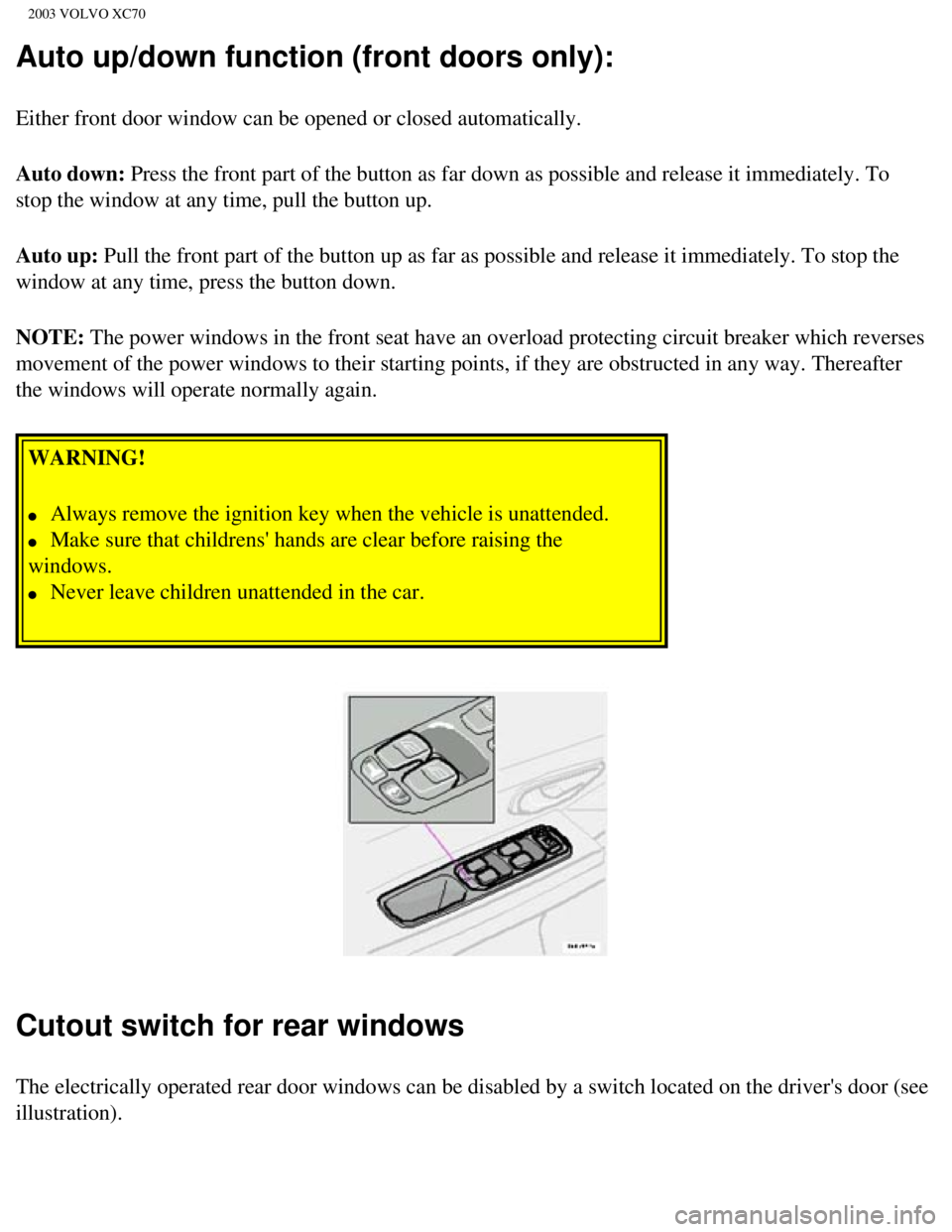
2003 VOLVO XC70
Auto up/down function (front doors only):
Either front door window can be opened or closed automatically.
Auto down: Press the front part of the button as far down as possible and release i\
t immediately. To
stop the window at any time, pull the button up.
Auto up: Pull the front part of the button up as far as possible and release it i\
mmediately. To stop the
window at any time, press the button down.
NOTE: The power windows in the front seat have an overload protecting circuit \
breaker which reverses
movement of the power windows to their starting points, if they are obst\
ructed in any way. Thereafter
the windows will operate normally again. WARNING!
l Always remove the ignition key when the vehicle is unattended.
l Make sure that childrens' hands are clear before raising the
windows.
l Never leave children unattended in the car.
Cutout switch for rear windows
The electrically operated rear door windows can be disabled by a switch \
located on the driver's door (see
illustration).
file:///K|/ownersdocs/2003/2003_XC70/03xc70_02b.htm (13 of 18)12/30/20\
06 4:17:54 PM
Page 131 of 257
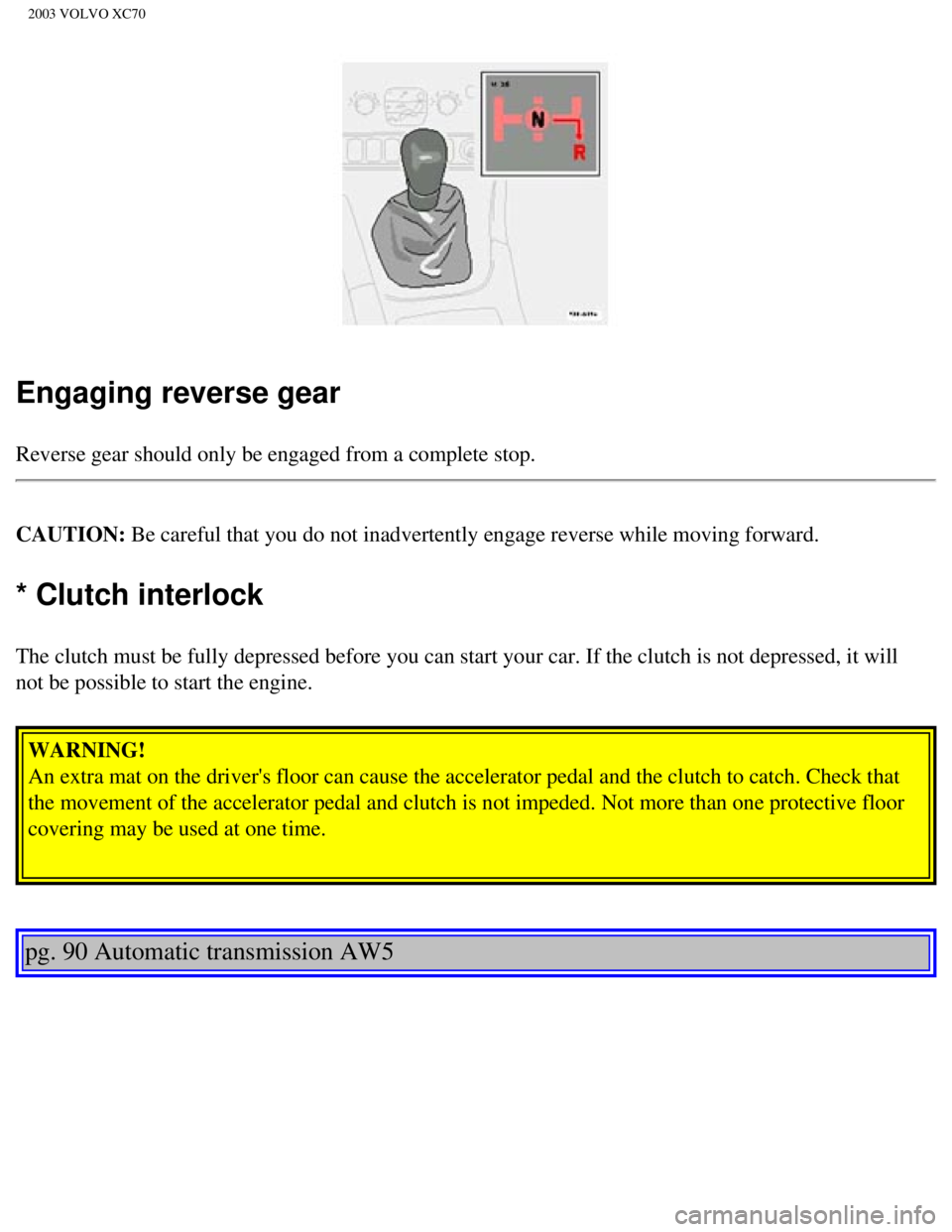
2003 VOLVO XC70
Engaging reverse gear
Reverse gear should only be engaged from a complete stop.
CAUTION: Be careful that you do not inadvertently engage reverse while moving for\
ward.
* Clutch interlock
The clutch must be fully depressed before you can start your car. If the\
clutch is not depressed, it will
not be possible to start the engine. WARNING!
An extra mat on the driver's floor can cause the accelerator pedal and t\
he clutch to catch. Check that
the movement of the accelerator pedal and clutch is not impeded. Not mor\
e than one protective floor
covering may be used at one time.
pg. 90 Automatic transmission AW5
file:///K|/ownersdocs/2003/2003_XC70/03xc70_06a.htm (8 of 22)12/30/200\
6 4:17:59 PM
Page 139 of 257
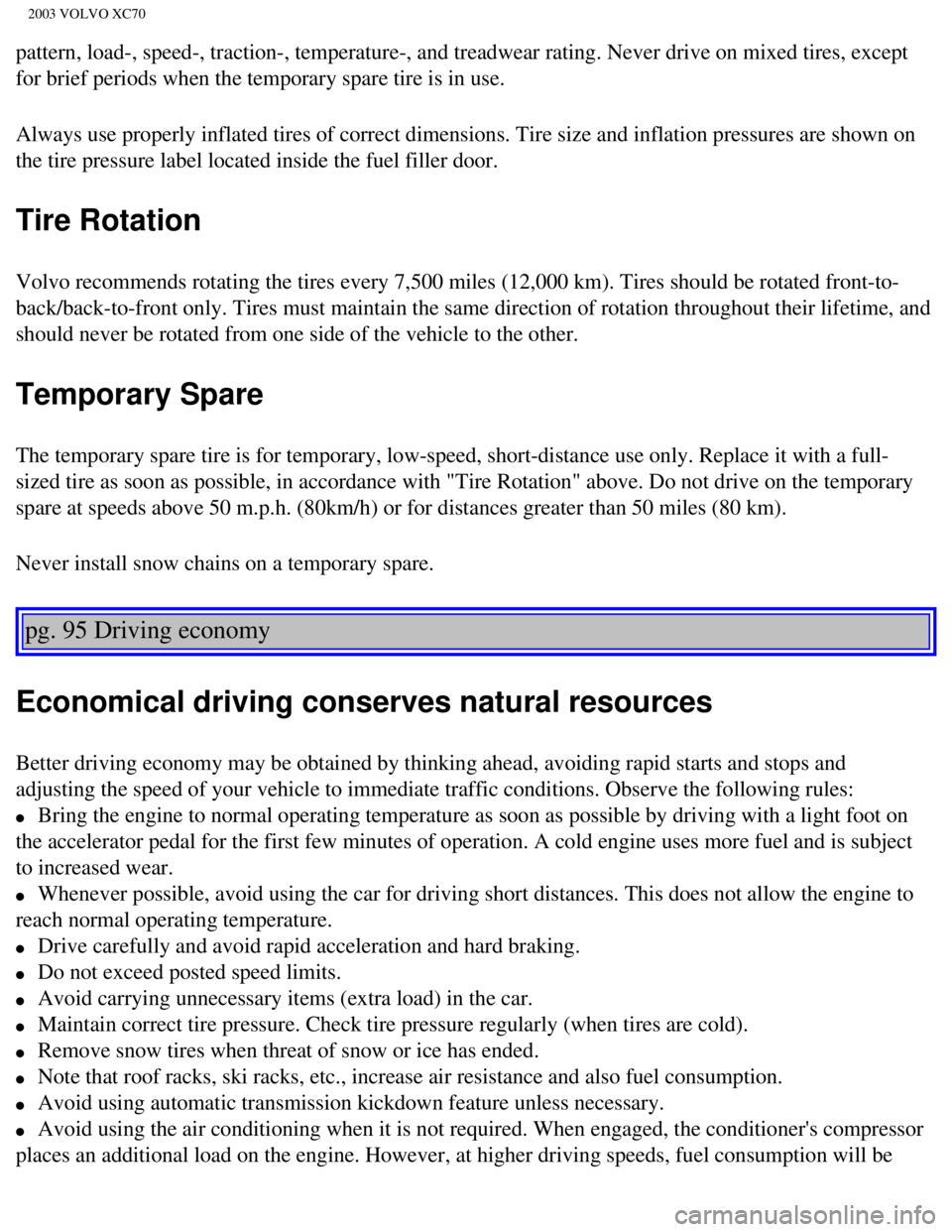
2003 VOLVO XC70
pattern, load-, speed-, traction-, temperature-, and treadwear rating. N\
ever drive on mixed tires, except
for brief periods when the temporary spare tire is in use.
Always use properly inflated tires of correct dimensions. Tire size and \
inflation pressures are shown on
the tire pressure label located inside the fuel filler door.
Tire Rotation
Volvo recommends rotating the tires every 7,500 miles (12,000 km). Tir\
es should be rotated front-to-
back/back-to-front only. Tires must maintain the same direction of rotat\
ion throughout their lifetime, and
should never be rotated from one side of the vehicle to the other.
Temporary Spare
The temporary spare tire is for temporary, low-speed, short-distance use\
only. Replace it with a full-
sized tire as soon as possible, in accordance with "Tire Rotation" above\
. Do not drive on the temporary
spare at speeds above 50 m.p.h. (80km/h) or for distances greater than\
50 miles (80 km).
Never install snow chains on a temporary spare.
pg. 95 Driving economy
Economical driving conserves natural resources
Better driving economy may be obtained by thinking ahead, avoiding rapid\
starts and stops and
adjusting the speed of your vehicle to immediate traffic conditions. Obs\
erve the following rules:
l Bring the engine to normal operating temperature as soon as possible by \
driving with a light foot on
the accelerator pedal for the first few minutes of operation. A cold eng\
ine uses more fuel and is subject
to increased wear.
l Whenever possible, avoid using the car for driving short distances. This\
does not allow the engine to
reach normal operating temperature.
l Drive carefully and avoid rapid acceleration and hard braking.
l Do not exceed posted speed limits.
l Avoid carrying unnecessary items (extra load) in the car.
l Maintain correct tire pressure. Check tire pressure regularly (when tir\
es are cold).
l Remove snow tires when threat of snow or ice has ended.
l Note that roof racks, ski racks, etc., increase air resistance and also \
fuel consumption.
l Avoid using automatic transmission kickdown feature unless necessary.
l Avoid using the air conditioning when it is not required. When engaged, \
the conditioner's compressor
places an additional load on the engine. However, at higher driving spee\
ds, fuel consumption will be
file:///K|/ownersdocs/2003/2003_XC70/03xc70_06a.htm (16 of 22)12/30/20\
06 4:18:00 PM
Page 251 of 257

2003 VOLVO XC70
Sideview mirrors - memory function 41
Snow chains
109
Snow tires
109
Spare tire
72, 110
Spark plugs
132, 147
Specifications
144
SRS
6
SRS diagnostic system
28
Stability Traction Control (STC)
19, 31
Stain removal
128
Start inhibitor (immobilizer)
76, 87
Starting the engine
87, 88
Steel grid
69
Steering wheel adjustment
35
Steering wheel lock
35
Stop and Store bag
64
Storage compartments
59
Storage in the glove compartment
60
Studded tires
109
Subwoofer
72, 166
Sun roof
42, 43
Supplemental Restraint System
4, 28
Suspension
147
Switches in center console
31
T
Tachometer
27
Tailgate - locking/unlocking
79
Tailgate wiper blade - replacing
140
Temperature gauge
27
Temporary spare tire
110
Text window
30
Three-way catalytic converters
106
file:///K|/ownersdocs/2003/2003_XC70/03xc70_12.htm (10 of 12)12/30/200\
6 4:18:09 PM